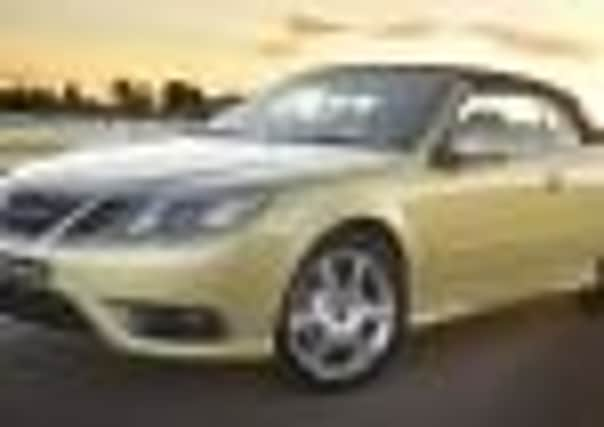Saab convertible keeps the flag flying


Staff wages have gone unpaid, debtors are queueing up, there has been no money to make cars. The sorry picture changes daily. This month it went into “voluntary reorganisation” to give it time to restructure the business. It’s not a selling point for dealers anxious to move metal but Saab GB says it is not affected, is not part of the reorganisation and has sufficient funds to trade as normal.
I am a keen Saabist. I even owned a 96, with a Ford V4 engine – this being, I think, the first time Saab had bought in an engine after its debut with oily two-strokes based on a DKW design.
Advertisement
Hide AdAdvertisement
Hide AdIts giddy turbo days in the late 1970s relied on Triumph engines. It also had a shared model with Fiat Group, which produced the Saab 9000 in 1985, the Alfa Romeo 164, Lancia Thema and Fiat Croma. Its last major partner for engines and chassis was Opel Vauxhall, a reliance which continues after its sale by GM.
While market pressures suggest there is little room for Saab to prosper, it has loyal customers, albeit they have dwindled as model development slowed and “the rest” moved onwards. Its 9-3 is now a leftfield alternative, not really a contender. The much newer 9-5 is scarcely visible. The glory days are gone, probably forever.
Sales in Britain are, at least, going in the right direction, up 27 per cent in the first eight months at 3,774. That is more than Smart has sold, and slightly ahead of Porsche.
Setting nostalgia aside, there is one reason why Saab must continue, and it is this convertible version of the 9-3, a model that always turns my head and stands comparison with the soft-top Audi A4 and the folding hard-top BMW 3.
A Saab convertible has the tangible attribute of terrific looks. It’s a Hollywood or even Bollywood stunner, long and low, delicious. It does not have the chassis integrity of its German peers but it has improved. There is still some steering vibration on substandard roads but I can’t see the buyer worrying about that.
Saab has been working to get emissions down to suit company drivers but running costs will be a secondary consideration for the convertible customer.
The lead-in model is the 158bhp 1.9-litre turbo diesel SE, at £27,500. There is a 177.5bhp version at £28,000 and 160.7bhp 2.0-litre turbo petrol at £27,510 – so not much difference in pricing between the three.
The 177.5bhp diesel is sold in sportier, plusher Aero trim at £31,750 and there is a 217bhp 2.0-litre petrol turbo 2.0T Aero at £32,010. All use a six-speed manual gearbox. A six-speed automatic is an extra £1,380.
Advertisement
Hide AdAdvertisement
Hide AdMy test car was the top gun 2.0T. Extras pushing up the price included a satnav system (£2,025) and premium leather sports interior (£1,175).
Audi A5 cabriolet prices start at just under £29,000, and you’ll be asked to pay £33,700 for the cheapest BMW 3-Series convertible.